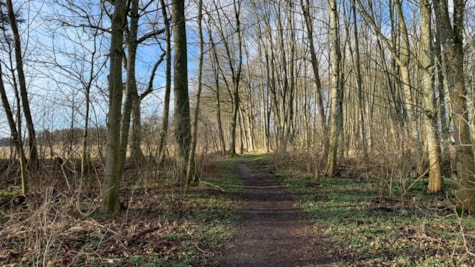Hiking route: Historical route, Count's Path - 0,9 km
Distance: 155.94 Km
Follow in Count Moltke's footsteps
It is said that the path got the name Count's Path because in 1754, when Sheriff Adam Gottlob Moltke bought Dronninglund Castle, a controversy arose between his manager Rosen and a tenant farmer about who should maintain and clean the Smedebækken.
Smedebækken is also called Nunnernes Vandløb because it supplies the fishponds around Dronninglund Castle, the former Hundslund Monastery, with water.
More than 900 years ago, when the nuns lived at Hundslund Monastery, the monks in the area diverted the stream: They wanted the nuns to wash their clothes, and therefore they diverted the stream, so that the nuns got water at the monastery. After the stream was diverted, it entered in front of the current Dronninglund Hovedgård, across the courtyard, past the animals' watering place, to finally run into the nuns' utility room and kitchen. The water then ran down to the castle's water mill, through the carp pond to finally end up in Øster Møllesø.
Who was strike Moltke?
Adam Gottlob Moltke var German-Danish County Count and one of the richest and most powerful men of his time. Then han bought Dronninglund Castle i 1754, hired he the well-known architect and landowner Laurids de Thurah to be responsible for an extensive reconstruction of the castle. Adam G. Moltke also had the beautiful castle garden laid out.
Count Moltke had a total of 22 children in two marriages which made the Moltke family large and influential in Denmark.
In the nobility footprint
Smedebækken is also called Nunnernes Vandløb because it supplies the fishponds around Dronninglund Castle, the former Hundslund Monastery, with water.
More than 900 years ago, when the nuns lived at Hundslund Monastery, the monks in the area diverted the stream: They wanted the nuns to wash their clothes, and therefore they diverted the stream so that the nuns had water fed to the monastery. After the stream was diverted, it entered in front of the current Dronninglund Manor, across the courtyard, past the animals' drinking place and finally ran into the nuns' utility room and kitchen. The water then ran down to the castle's water mill, through the carp pond, to finally end up in Øster Møllesø.
The area around Øster Møllesø is today one scenic recreational area with fine paths. In the past, there was a water mill from the 16th century by the lake, and part of the mill house has been preserved.
On your trip to Øster Mølleso you can also drop by Margrethe-eigen, which has more than 700 years behind it. You can also let yourself be captivated by the beautiful Dronninglund Castle.
Dronninglund Castle: From nunnery to modern castle collective
Hundslund Kloster, as Dronninglund Castle was called in the past, mentioned for the first time approx. year 1260. That was until the Reformation in 1536 a monastery for nuns from the oldest monastic order, the Benedictines. However, the monastery was in all probability already an old and well-regarded institution at the time.
The nunnery became one of Denmark's richest when Queen Margrethe the First endowed it with rich gifts in a deed of gift dated 6 July 1393. Hundslund now came into possession of more than 100 farms in Vendsyssel.
After the Reformation, the monastery came under the crown, handled by sheriffs, i.a. two of the family Corfitz Ulfeldt and Peter Munk.
From 1581 the monastery ceased to be crown property and was taken over by the gentleman Hans Johansen Lindenow. He built a new castle yard with the two corner towers, which still stand today. He also built the farm, which at the time was one of Jutland's largest breeding farms.
From 1690 to 1729, the castle, church and manor were again in the possession of the royal house. Christian the V's queen, Charlotte Amalie took over the castle and renamed it to its current name, Dronninglund. After the queen's death, her son Frederik IV Dronninglund took over, but he transferred it the following year to his sister, Princess Sophie Hedevig. In 1719 signed hun en foundation for the establishment of seven princess schools in the Dronninglund area. She also saw to it that the church was thoroughly restored, and she thus gained great importance for the great Dronninglund Parish.
Among Secondly, known owners of Dronninglund were the Greenland explorer Jacob Severin from 1736 to 1753, as well as the subsequent owner, Count Adam Gottlob Moltke, who, among other things, laid out the magnificent castle garden – and possibly gave its name to the path here.
Dronninglund Castle is today privately owned and the old buildings create new value as a castle collective with rental of premises for living and business, with respect for the historical setting.
Updated by: Destination NORD | info@destination-nord.dk

